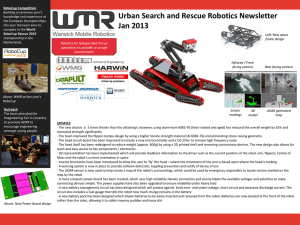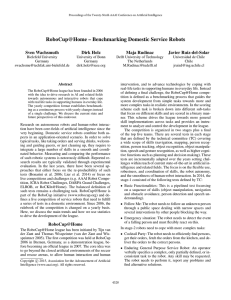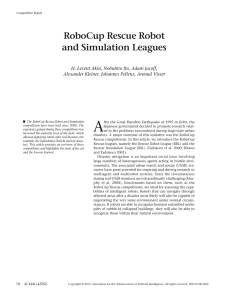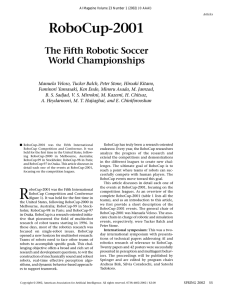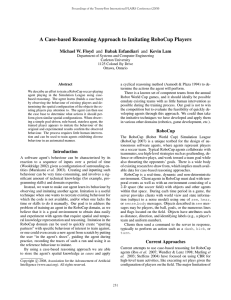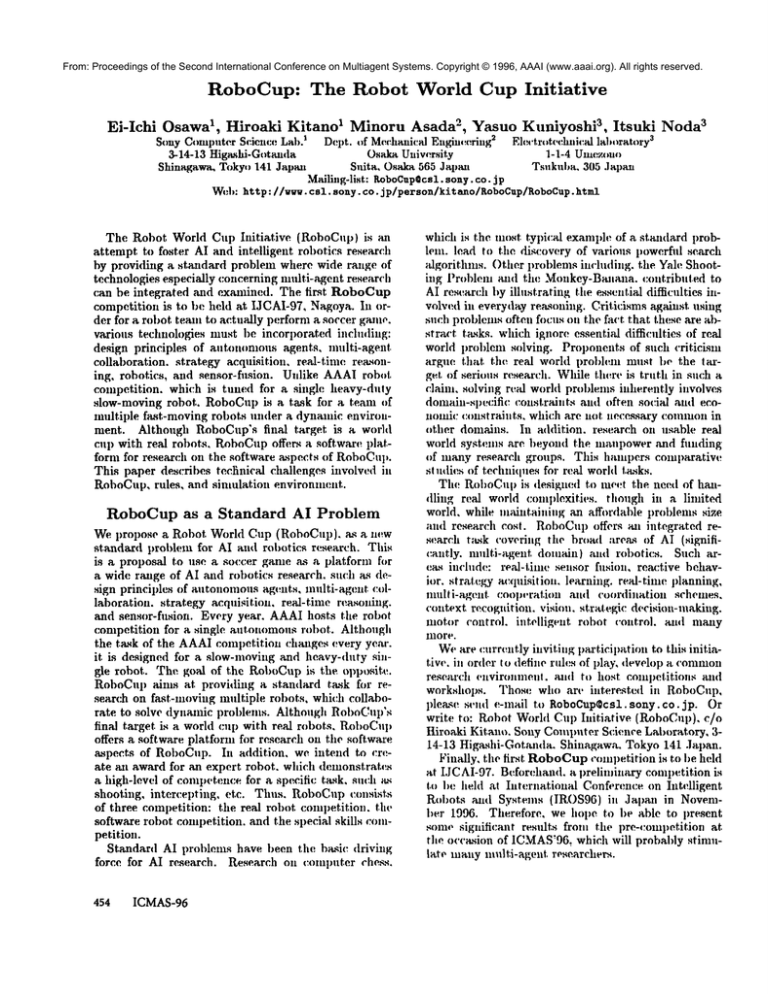
From: Proceedings of the Second International Conference on Multiagent Systems. Copyright © 1996, AAAI (www.aaai.org). All rights reserved.
RoboCup: The Robot World Cup Initiative
Ei-Ichi
Osawa 1, Hiroaki
Kitano 1 Minoru Asada 2, Yasuo Kuniyoshi 3, 3Itsuki
Noda
3Eh:ctrot(’chnic’,dla]mratory
Sony Comlmtcr Science LabJ 2Dept. of MechanicalEngineering
Osaka Uniw’rsity
3-14-13 Higashi-Gotanda
1-1-4 Umczmm
Tsukuba, 305 Japan
Shinagawa, Tokyo 141 Japan
Suita, Osaka565 Japan(
Mailing-list: RoboCup~csl.
sony. co. jp
Web: http://uww.csl.sony.co.jp/person/kitano/RoboCup/RoboCup.html
The Robot World Cup Initiative
(R, oboCup) is
attempt to foster AI and intelligent rohoties research
by providing a standard problem where wide range of
technologies especially concerning multi-agent research
(:an be integrated and examined. The first RoboCup
competition is to be, heht at. IJCAI-97, Nagoya. In order for a robot team to actually perform a soccer game.
various technologies must I)e incorl)orated including:
design principles of autononmus agents, multi-agent
collaboration, strategy acquisition, real-time rea.~oning, robotics, and sensor-fllsion.
Unlike AAAIrobot
competition, which is tuned for a single heavy-duty
slow-moving robot. RoboCupis a task for a team of
multiple f‘ast-moving robots under a dynamic environmen(. Although RoboCnp’s final target is a worhl
cup with real robots, RoboCupoffers a soft.ware platform for reseaxch on the software aspects of RoboCup.
This paper describes teclini(’M challenges involw~d in
RoboCup, rules, and simulation environment.
RoboCup
as
a Standard
AI
Problem
We prol)ose a Robot World Cup (RoboCup). ‘au a
standard problem for AI and rol~otics research. This
is a proposal to use a so(:cer game,as a platform fl~r
a wide range of AI and robotics research, su(:h as design principles of autonomousag~.nts, multi-age, n( collaboration, strategy acquisition, real-time reasoning.
and sensor-fitsion.
Every year. AAAIhosts the robot
competition for a single autonomous robot. Although
the task of the AAAIcompetition changes every year.
it is designed for a slow-moving and heavy-duty single robot. The go’,d of the RoboCupis the Ol)l>~mite.
RoboCupalms at providing a standard task for research on fast-moving multiple rol)ots, which collaborate to solve dynamic prol)lems. Although Rol)oCup’s
final target is a world cup with real robots, R.oboCul~
offers a software platform for research on the software
,aupects of RoboCul). In addition, we intend to create azt award for an expert robot, which demonstrates
a high-level of eomt~ete,nce for a specific task, such ;,-~
shooting, intercepting, etc. Thus. Rol)oCup consists
of three competition: the real robot COml~etition. the
software robot coml)etition, and the special skills competition.
Standard AI prol)lems have been the ba.~ic driving
force for AI research. Research on computer chess.
454
ICMAS-96
-which is the most typical exampleof a staatdard l)rob
lem. lead to the discovery of various powerfid search
algorithms. Other l)rol)lems inchtding, the Yale Shooting Prol)lem and the Monkey-Banana. contributed to
AI research by illustrating the essential difficulties involved in everyday reasoning. Criticisms against using
such prol)lems often focus on the fact that these are al)str~wt t~,sks, whichignore essential difficulties of real
world i~roblem solving. Proponents of such criticism
argue that the real worht l)roi~h~m must b,’ the large(. of serious research. While there is truth in such
claim, re)lying re~d worhi problems inherently involves
donxain-specific constraints aml often social att<l economicconstraiuts, which are not necessary COlllnlon in
other donlaJns. In addition, research on usable real
world systems are beyond the manl)ower and funding
of lnally research groups. This hampers COml)aratiw~
st udies of techniques for real worhl t,asks.
The l~oboCup is designed to meet the need of handling real worht (:omplexities. though in a limited
world, while m;fintaining an affordable prot)lenls size
and research cost. RoboCu
I) offers aal integrated research task covering the broad are‘a~ of AI (significantly, nmlti-agent domain) and roboti(:s. Such areas include: real-l.imc sensor fltsion, reactive behavior. strategy acquisition, learning, real-time planning,
multi-agent COOlwration aml coordination schemes,
context recognition, vision, strategic decision-making.
motor control, intelligent robot control, and maaly
lllOr~,.
Weare currently ivviting paa’ticil~ation to this initiatiw,, in order to define ruh:s of play, develop a common
resear(’h environment, and tt) host COmlw.titions and
workshops. Those who art, interested
in RoboCup,
l)lea,~e semi e-mail to RoboCup~csl.sony.co.jp. Or
write to: R~)bot Worhl Cui) hfitiative (RoboCup), c/o
Itiroaki Kitano. Sony ComputerScience Laboratory, 314-13 Higashi-Gotanda. Shinagawa. Tokyo 141 .lal)an.
Finally, the first RoboCupcompetition is to be held
at IJCAI-97. Beforehand. a preliminary competition is
l.o I(e heht at International Conferenceon Intelligent
Robots and Systems (IR.OS96) in Japan in November 1996. Therefore, we hope to I)e able to present
som~, significant results from the pre-coml)etition at
the o(’(’a.sion of ICMAS’96,
which will probably stimulate manymulti-agent researchers.

